Holding Submicron Part Tolerances
Sunlight-Tech Inc. has used GF Machining Solutions’ Microlution laser micromachining and micro-milling centers to produce parts with tolerances tighter than 1 micron.
Share





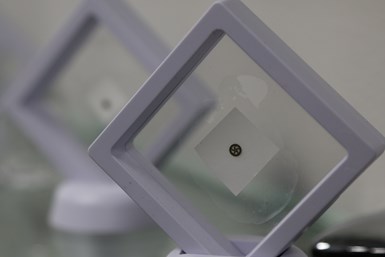
Sunlight-Tech Inc. specializes in using laser machining and micro-milling to produce parts with components with tolerances at the submicron level.
For many job shops, part tolerances of 0.0003 to 0.0005 inch are tight. At Sunlight-Tech Inc. in Mokena, Illinois, routine jobs can involve tolerances tighter than 1 micron (0.00003937 inch) — requirements that are challenging to achieve with conventional CNC machining or even electrical discharge machining (EDM). In addition, many of the shop’s parts are almost microscopic or require miniscule, intricate features. According to Sunlight Tech’s president Grzegorz (Greg) Nowobilski, the shop can only complete this work with laser micromachining and micro-milling technology on machines that can move just as precisely as the submicron part tolerances the shop needs to hold.
Meeting Micro Requirements
The 22-person shop opened in 2010 as an engineering consultant focused on designing machinery and automation. In 2018, Sunlight expanded beyond consultancy and diversified into micro-laser and micro-milling machining. As a result, it now serves a wide array of customers in the automotive, food, consumer goods, aerospace, defense, electronics, communications and medical industries.
With its laser micromachining capabilities, Sunlight fulfills such customer job requirements as generating 3,200 holes — each 254 microns in diameter at a 11:1 depth-to-diameter ratio — or producing features that are square at the top and round at the bottom with positive or negative tapers, along with other kinds of cavities and blind features. It also uses its laser technology for those parts that must not be contaminated or come in contact with foreign materials, something the shop says is a common risk during conventional milling operations involving cutting tools. Because most of the parts are extremely tiny and fragile, Sunlight micromachines them using lasers to avoid creating any damaging cutting forces.
The Right Tools for the Job
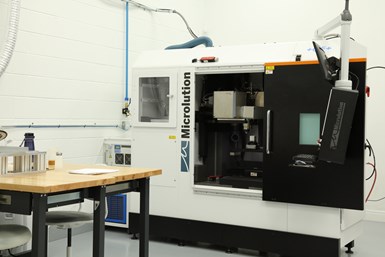
Sunlight’s Microlution ML-5 machines feature full five-axis laser movement to “bend” the beam to generate complex shapes not possible with conventional drilling.
Currently, Sunlight has two ultrafast laser micromachining systems from GF Machining Solutions: a Microlution ML-5 five-axis machine and a Microlution ML-5 three-axis machine with a larger working envelope.
The Microlution ML-5s are capable of delivering ±1 μm positional accuracy and ±0.5 μm repeatability. The ML-5s’ full five-axis laser movement is capable of “bending” the beam to generate highly complex shapes that would not be possible with conventional drilling, such as for GDI fuel-injector nozzles that use precisely positioned and machined spray holes to achieve the desired flow rate and spray pattern within an engine’s cylinder. Customers for these parts generally require negative tapered holes of around 4 degrees, less than 0.3 μm Ra, diameter repeatability around ±1 μm and positioning tolerances of just a few microns.
Precision-ground natural granite bases and granite-mounted rails support the machines’ high-precision beam delivery systems. The bases are designed to provide high thermal stability over extended production runs to maintain part quality. According to GF Machining Solutions, high-accuracy linear motors allow the machines to reach peak acceleration with no blacklash and significantly reduced cycle times and consumables. Other features include high-resolution glass scale encoders as well as in-line workpiece touch probes, integrated power meters and high-speed optical cameras.
Both machines use femtosecond laser technology — the lasers pulse in the range of one quadrillionth of a second. They eliminate most burr formation and their ultrashort pulse duration prevents materials from entering a fusion state during machining, which GF Machining Solutions says makes these lasers suitable for Sunlight’s heat-sensitive parts.
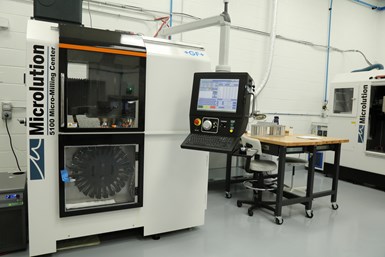
Sunlight’s Microlution 5100 micro-milling center has enabled the shop to tackle high-precision, small-part applications such as those for medical micro-fluidics.
On the micro-milling side, Sunlight uses its Microlution 5100 micro milling center with high-speed, five-axis micro-milling technology to produce highly precise parts with complex geometries. Designed to manufacture tiny components while maintaining micron-level precision, the machine handles parts measuring up to 4 × 4 × 4 inches using cutting tools ranging from 0.0004 to 0.124 inch in diameter. With its ±0.00004 inch positioning accuracy, GF Machining Solutions says the high-performance, vertical-bridge-style linear-motor machining center is well-suited for Sunlight’s high-precision, small-part applications, such as those for medical micro-fluidics, which demand holding the geometric tolerances of channels to ±3 μm.
From R&D to Production Runs
Many of Sunlight’s laser micromachining jobs involve R&D work. According to Nowobilski, since ultrashort-pulse laser machining is less than a decade old, companies are experimenting with the technology to see how it can benefit parts they currently produce. Sunlight helps them prove out those concepts.
These prototyping exercises typically start with the shop cutting one or two sample parts for the customer to evaluate. From there, customers may request as many as 25 to 50 pieces to test in the implementation of the product design. If that testing is successful, the customer may order full production of the components from Sunlight, with lot sizes ranging from 10 to several hundred parts per month. Typical part cycle times range from a few seconds to four or five hours for components with multiple features required — such as 220 holes in a single part — or, at the high end, up to six hours for components with complicated features.
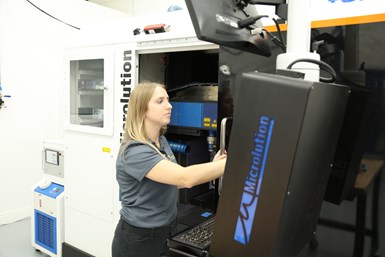
Sunlight application engineer Kelsey Tschetter was able to comfortably program the ML-5 five-axis machine after roughly three months.
“A key factor of effective laser machining is determining the correct laser parameters,” says Nowobilski, “and for that we worked with GF Machining Solutions’ applications engineering support team to develop those parameters.”
This support, combined with Nowobilski’s previous laser experience, allowed Sunlight to quickly get up to speed in programming the Microlution machines. As he explained, “After only a few weeks, we understood the laser parameters and how they needed to change to generate specific part shapes and features.”
For application engineer Kelsey Tschetter, being able to comfortably program the Microlution machine took only about three months. She programs, sets up and runs the ML-5 five-axis machine while working with her colleagues to develop how a job will run. Referencing past projects has helped her shorten lead times by a significant amount on many of those jobs.
Related Content
Foba Laser Marking Solutions Enable Efficient Industrial Product Marking
IMTS 2024: Foba is demonstrating its laser marking solutions in a range of sizes, from compact to large. Its V series is said to optimize precision and performance in a compact model.
Read MoreOmax Waterjet System Improves Efficiency, Precision
IMTS 2024: The Omax OptiMAX 60X waterjet system, equipped with optimized software and cutting capabilities, provides efficiency in production and precision.
Read MoreIndustrial Laser Conference Inspires with All-Women Panel
The Laser Institute of America hosts the Industrial Laser Conference, featuring speakers like Joy Gockel and a focus on the use of laser technology for additive manufacturing.
Read MoreRobot-Ready Laser Marking Machines Hit the Show Floor
Laser Marking Technologies LLC (LMT) is highlighting its robot readiness not only in its booth but also in its customers’ booths and partners Universal Robots and FANUC booths.
Read MoreRead Next
5 Tips for Making the Switch to Micromachining
Working at the micro-level requires changing the way you approach machining parts, and these tips can help you avoid pitfalls.
Read More4 Takeaways for Shops New to Micromachining
By taking the plunge into micromachining, one Minnesota micro molding and machining shop now specializes in the design and production of parts 0.015 inch and smaller. Here is that story and the lessons learned in the process.
Read MoreMachine Shop Fills Mold Repair Niche with Fiber Laser
After getting calls for plastics injection mold repair services that its MIG and TIG welders couldn’t handle, CMS Inc. acquired fiber laser technology from LaserStar to meet demand.
Read More



























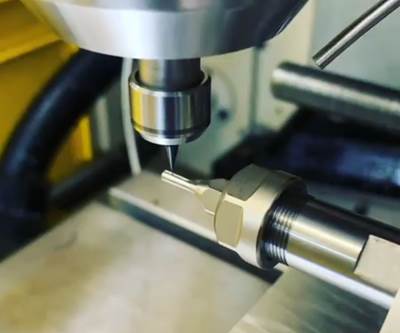


.jpg;maxWidth=970;quality=90)